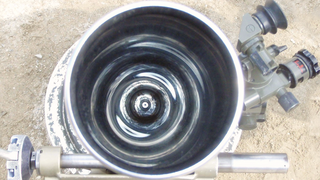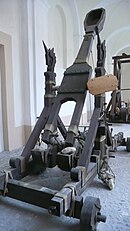
A catapult is a ballistic device used to launch a projectile a great distance without the aid of gunpowder or other propellants – particularly various types of ancient and medieval siege engines. A catapult uses the sudden release of stored potential energy to propel its payload. Most convert tension or torsion energy that was more slowly and manually built up within the device before release, via springs, bows, twisted rope, elastic, or any of numerous other materials and mechanisms.

A missile is an airborne ranged weapon capable of self-propelled flight aided usually by a propellant, jet engine or rocket motor.

A sling is a projectile weapon typically used to hand-throw a blunt projectile such as a stone, clay, or lead "sling-bullet". It is also known as the shepherd's sling or slingshot. Someone who specializes in using slings is called a slinger.

The ballista, plural ballistae, sometimes called bolt thrower, was an ancient missile weapon that launched either bolts or stones at a distant target.

A bullet is a kinetic projectile, a component of firearm ammunition that is shot from a gun barrel. They are made of a variety of materials, such as copper, lead, steel, polymer, rubber and even wax; and are made in various shapes and constructions, including specialized functions such as hunting, target shooting, training, and combat. Bullets are often tapered, making them more aerodynamic. Bullet size is expressed by weight and diameter in both imperial and metric measurement systems. Bullets do not normally contain explosives but strike or damage the intended target by transferring kinetic energy upon impact and penetration.

A projectile is an object that is propelled by the application of an external force and then moves freely under the influence of gravity and air resistance. Although any objects in motion through space are projectiles, they are commonly found in warfare and sports.

External ballistics or exterior ballistics is the part of ballistics that deals with the behavior of a projectile in flight. The projectile may be powered or un-powered, guided or unguided, spin or fin stabilized, flying through an atmosphere or in the vacuum of space, but most certainly flying under the influence of a gravitational field.

A smoothbore weapon is one that has a barrel without rifling. Smoothbores range from handheld firearms to powerful tank guns and large artillery mortars.

A gun barrel is a crucial part of gun-type weapons such as small firearms, artillery pieces, and air guns. It is the straight shooting tube, usually made of rigid high-strength metal, through which a contained rapid expansion of high-pressure gas(es) is used to propel a projectile out of the front end (muzzle) at a high velocity. The hollow interior of the barrel is called the bore, and the diameter of the bore is called its caliber, usually measured in inches or millimetres.
Internal ballistics, a subfield of ballistics, is the study of the propulsion of a projectile.
Hitscan in video game design, most commonly in first-person shooters, is a type of hit registration system that determines whether an object has been hit or not simply by scanning if the item used was aimed directly at its target and then applies the effects of the item instantly. A weapon, for example, does not launch a projectile the player needs to lead, damage is applied as soon as the player's crosshair is on a target and the fire button is pressed. Internally, this is most commonly done by simulating a ray from the origin of the item along the trajectory of the "projectile" and simply scanning for any objects touching the ray. Games might still show a visual of a projectile although it technically has no effect. In contrast, a projectile-based weapon would launch an actual projectile object that moves through the virtual space at a certain speed and will apply damage only once it has actually touched ("hit") a target.

A ranged weapon is any weapon that can engage targets beyond hand-to-hand distance, i.e. at distances greater than the physical reach of the user holding the weapon itself. The act of using such a weapon is also known as shooting. It is sometimes also called projectile weapon or missile weapon because it typically works by launching solid projectiles ("missiles"), though technically a fluid-projector and a directed-energy weapon are also ranged weapons. In contrast, a weapon intended to be used in hand-to-hand combat is called a melee weapon.
Darts are airborne ranged weapons. They are designed to fly such that a sharp, often weighted point will strike first. They can be distinguished from javelins by the presence of fletching and a shaft that is shorter and/or more flexible. Darts can be propelled by hand or with the aid of a hand-held implement such as a blowgun. They can be distinguished from arrows because they are not used with a bow.

In ballistics, the ballistic coefficient of a body is a measure of its ability to overcome air resistance in flight. It is inversely proportional to the negative acceleration: a high number indicates a low negative acceleration—the drag on the body is small in proportion to its mass. BC can be expressed with the units kilograms per square meter (kg/m2) or pounds per square inch (lb/in2).

A ballistic chronograph or gun chronograph is a measuring instrument used to measure the velocity of a projectile in flight, typically fired from a gun or other firearm. The instrument is often useful for tasks such as gauging the utility of a firearm or safety of non-lethal projectiles fired from items such as a paintball gun or BB gun.
The following are terms related to firearms and ammunition topics.

A kinetic energy weapon is a projectile weapon based solely on a projectile's kinetic energy to inflict damage to a target, instead of using any explosive, incendiary/thermal, chemical or radiological payload. All kinetic weapons work by attaining a high flight speed — generally supersonic or even up to hypervelocity — and collide with their targets, converting its kinetic energy and relative impulse into destructive shock waves, heat and cavitation. In kinetic weapons with unpowered flight, the muzzle velocity or launch velocity often determines the effective range and potential damage of the kinetic projectile.

Ammunition is the material fired, scattered, dropped, or detonated from any weapon or weapon system. Ammunition is both expendable weapons and the component parts of other weapons that create the effect on a target.
The Ballistic Research Laboratory (BRL) was a leading U.S. Army research establishment situated at Aberdeen Proving Ground, Maryland that specialized in ballistics as well as vulnerability and lethality analysis. BRL served as a major Army center for research and development in technologies related to weapon phenomena, armor, electronic devices, and high-speed computing. In 1992, BRL was disestablished and its mission, personnel, and facilities were incorporated into the newly created Army Research Laboratory (ARL).

Throwing is a physical action which consists of mechanically accelerating a projectile and then releasing it into a ballistic trajectory, usually with the aim of impacting a distant target. This action typically refers to hand-throwing by animals with prehensile forelimbs. In this case, the projectile is grasped in a hand while the proximal limb segments move through compounded kinematic chains to impart a mechanical advantaged swinging motion. For other animals, the definition of throwing is somewhat unclear, as other actions such as spitting or spraying may or may not be included.






















